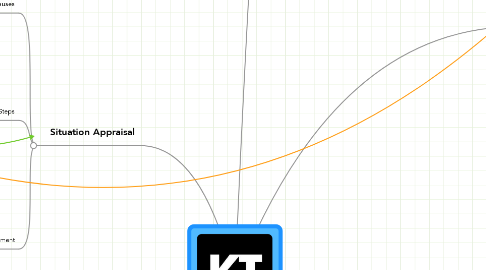
1. Situation Appraisal
1.1. Identify Causes
1.1.1. List Threats and Opportunities
1.1.1.1. More resources could be good to have better work management
1.1.1.2. Traing to new resources
1.1.1.3. More work and revenue
1.1.2. Separate and Clarify Concerns
1.1.2.1. Relationship with customers
1.1.2.2. Meetings with customers
1.2. Plan Next Steps
1.2.1. Determine Analysis Needed
1.2.1.1. Situation Appraisal
1.2.1.1.1. Do we need further clarification?
1.2.1.2. Problem Analysis
1.2.1.2.1. Do we have a deviation?
1.2.1.2.2. Is the cause unknown?
1.2.1.2.3. Do we need to know the cause of a deviation to take effective action?
1.2.1.3. Potential Problem (Opportunity) Analysis
1.2.1.3.1. Do we have an action or plan to protect/enhance?
1.2.1.4. Decision Analysis
1.2.1.4.1. Do we need to make a choice?
1.3. Plan Involvement
1.3.1. Determine Help Needed
1.3.1.1. Resource Tarining and coaching
1.3.1.2. Resources who have less projects in hand
1.3.1.2.1. Yes
1.3.1.2.2. Training
1.3.1.2.3. Yes
1.3.1.2.4. Yes
1.3.1.2.5. Yes
1.3.1.3. Who will document our process and results?
2. Decision Analysis
2.1. Clarify the Purpose
2.1.1. State the Decision
2.1.1.1. Discipline about following Scrum methodology
2.1.1.2. Collaboration part has to be setup
2.1.2. Develop objectives
2.1.2.1. More upcoming projects in pipeline from customer
2.1.2.2. Outlook, Jira and Group chat
2.1.2.3. Unavailability of resource at onshore
2.1.2.4. Which objectives need to be clarified by making them more specific?
2.1.3. Classify objectives into MUSTs and WANTs
2.1.3.1. Coordination and information among team has to be more colloabarative
2.1.3.1.1. Yes
2.1.3.1.2. Yes
2.1.3.1.3. Yes
2.1.3.2. Travel and work from same location
2.2. Evaluate Alternatives
2.2.1. More resources and support
2.2.1.1. Fixed Terms, Existing Resource skill training
2.2.2. Resource skill training
2.2.2.1. New Joinee should be adaptive and contribute to development with quality
2.3. Make Decision
2.3.1. Introduce new resources or shadow resources for more capacity to handle multiple projects
2.3.1.1. New resource training and code quality.
3. Problem Analysis
3.1. Impact on productivity and less work satisfaction as developer
3.1.1. Communication
3.1.2. Project task delay and tasks moves from one sprint to another
3.1.3. Requirement description is short and vague. Co-ordination among new team members.
3.2. Ambiguity on resource availability
3.2.1. WHAT
3.2.1.1. IS
3.2.1.1.1. Missing practice of Scrum methodology
3.2.1.1.2. Bonding missing with new resources due to language, cultural background and in some occasion, no availability to clear their doubts
3.2.1.2. IS NOT
3.2.1.2.1. Release postpone due to 3rd party work and Processes
3.2.1.2.2. New Resource onboarding in the project
3.2.2. WHERE
3.2.2.1. IS
3.2.2.1.1. India ODC
3.2.2.1.2. Germany
3.2.2.2. IS NOT
3.2.2.2.1. Software architecture
3.2.3. WHEN
3.2.3.1. IS
3.2.3.1.1. Since Feb 2019 - till date
3.2.3.1.2. April
3.2.3.2. IS NOT
3.2.3.2.1. Feb 2019
3.2.4. EXTENT
3.2.4.1. IS
3.2.4.1.1. Work life balance
3.2.4.1.2. What is the trend?
3.2.4.2. IS NOT
3.2.4.2.1. Development, code quality
3.3. Identify Possible Causes
3.3.1. Knowledge and Experience
3.3.1.1. Fixed budget projects and unrealistic expectation from the customer
3.3.2. Distinctions and Changes
3.3.2.1. Not following Scrum practices
3.3.2.2. Research and Apollo project closure
3.3.2.3. 4th April 2019 - Release 1.0
3.3.2.4. Less projects makes it magenable
3.4. Evaluate Possible Causes
3.4.1. Test possible causes against the IS and IS NOT specification
3.4.1.1. If Missing Scrum practices the true cause of Ambiguity situation as it caused Less time booking,
3.4.2. Determine the most probable cause
3.4.2.1. More ongoing Activities/responsibilities than in past - Study, collaboration and Development.
3.5. Confirm True Cause
3.5.1. Verify assumptions, observe, experiment, or try a fix and monitor
3.5.1.1. More meetings and less work due to multiple projects
3.6. Think Beyond the Fix
4. Potential Problem (Opportunity) Analysis
4.1. Identify Possible Problems (Opportunities)
4.1.1. List Potential Problems (Opportunities)
4.1.1.1. Introduce new resources
4.2. Take Preventative (Promoting) Action
4.2.1. Outlooks Calendar blocking, Proactively communicate about missing Team calendar
